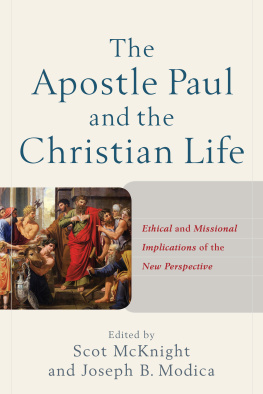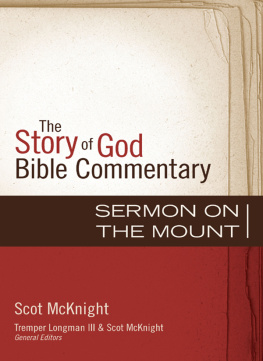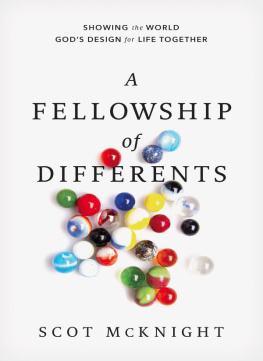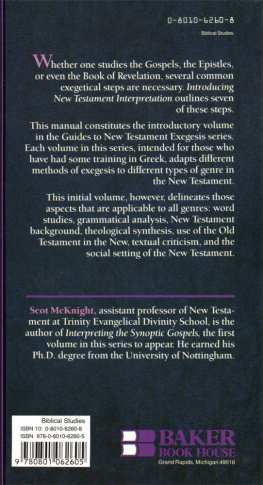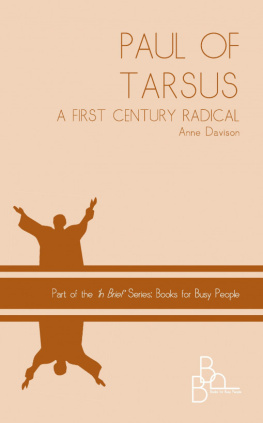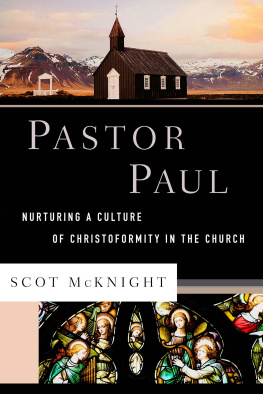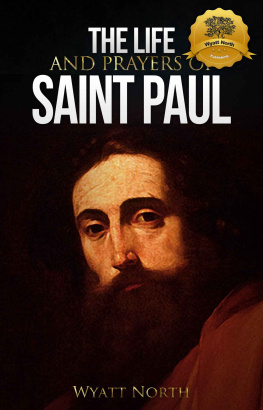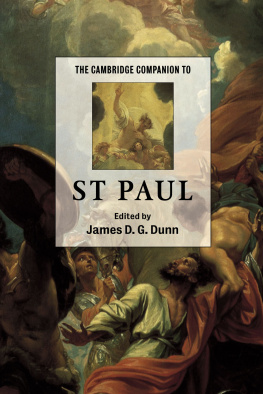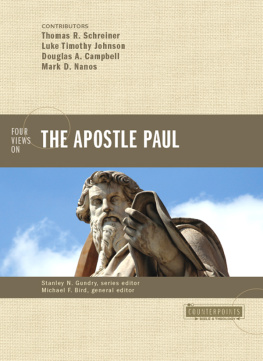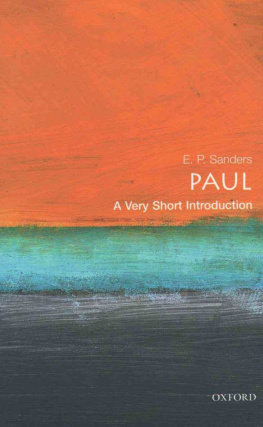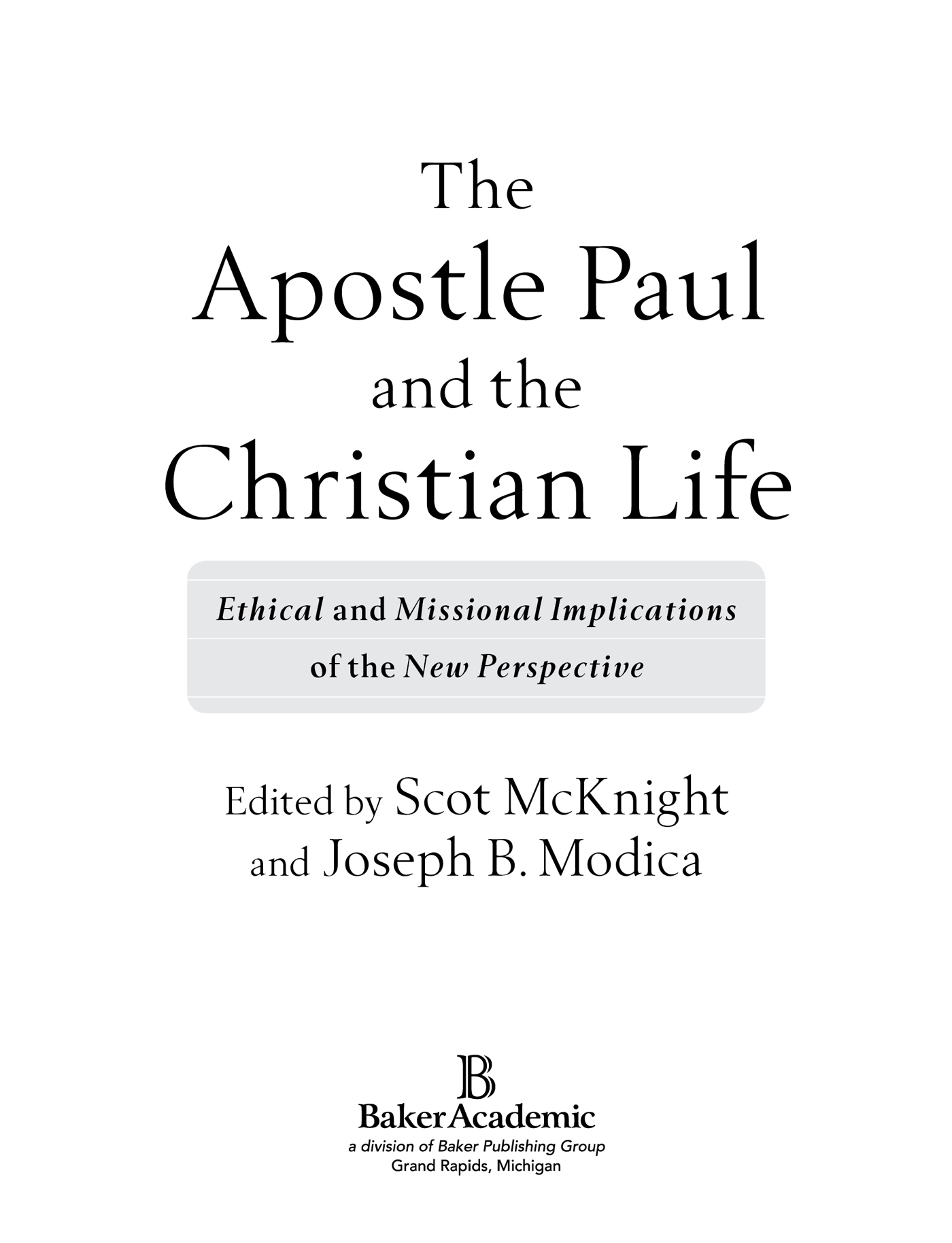Copyright Page
2016 by Scot McKnight and Joseph B. Modica
Published by Baker Academic
a division of Baker Publishing Group
P.O. Box 6287, Grand Rapids, MI 49516-6287
www.bakeracademic.com
Ebook edition created 2016
All rights reserved. No part of this publication may be reproduced, stored in a retrieval system, or transmitted in any form or by any meansfor example, electronic, photocopy, recordingwithout the prior written permission of the publisher. The only exception is brief quotations in printed reviews.
Library of Congress Cataloging-in-Publication Data is on file at the Library of Congress, Washington, DC.
ISBN 978-1-4934-0351-6
Scripture quotations labeled AT are those of the author.
Scripture quotations labeled ESV are from The Holy Bible, English Standard Version (ESV), copyright 2001 by Crossway, a publishing ministry of Good News Publishers. Used by permission. All rights reserved. ESV Text Edition: 2011
Scripture quotations labeled KJV are from the King James Version of the Bible.
Scripture quotations labeled NIV are from the Holy Bible, New International Version. NIV. Copyright 1973, 1978, 1984, 2011 by Biblica, Inc. Used by permission of Zondervan. All rights reserved worldwide. www.zondervan.com
Scripture quotations labeled NRSV are from the New Revised Standard Version of the Bible, copyright 1989, by the Division of Christian Education of the National Council of the Churches of Christ in the United States of America. Used by permission. All rights reserved.
Dedication
Scot McKnight dedicates this volume to
James D. G. Dunn
Emeritus J. B. Lightfoot Professor of Divinity,
University of Durham,
and Fellow of the British Academy,
who teaches about and dwells in the Spirit.
Joseph B. Modica dedicates this volume to
William V. Crockett
Professor Emeritus of New Testament,
Alliance Theological Seminary, Nyack, New York,
who teaches well by his scholarship and life.
. (1 Cor. 11:1)
Contents
Cover
Title Page
Copyright Page
Dedication
Acknowledgments
Introduction by Scot McKnight and Joseph B. Modica
1. The Christian Life from the Perspective of Pauls Letter to the Galatians
James D. G. Dunn
2. The New Perspective and the Christian Life in Pauls Letter to the Ephesians
Lynn H. Cohick
3. Faith, Works, and Worship: Torah Observance in Pauls Theological Perspective
Bruce W. Longenecker
4. The New Perspective and the Christian Life: Solus Spiritus
Patrick Mitchel
5. Participation in the New-Creation People of God in Christ by the Spirit
Timothy G. Gombis
6. The New Perspective and the Christian Life: The Ecclesial Life
Scot McKnight
Tara Beth Leach
8. Paul and Missional Hermeneutics
N. T. Wright
Selected Bibliography
List of Contributors
Index of Subjects
Index of Authors
Index of Scripture and Other Ancient Sources
Back Cover
Acknowledgments
W e want to thank Bob Hosack, executive editor at Baker Academic, for his encouragement for this project, along with our copy editor, Ryan Davis, and project editor, Tim West. All three editors improved our book significantly.
Our contributors did exceedingly well with the task at hand: to imagine what the apostle Paul thought of the Christian lifea bit of a daunting but necessary task for those committed to following Jesus in the twenty-first century. We thank our contributors for their skillfulness, for their diligence in meeting deadlines, and for their friendship.
We dedicate this book to our mentors (Scot McKnightJames D. G. Dunn; Joseph B. ModicaWilliam V. Crockett), who have taught us much about the apostle Paul and modeled for us what it means to live the Christian life.
Introduction
S COT M C K NIGHT AND J OSEPH B. M ODICA
O ne of the greatest double-play combinations in baseball history is Tinker to Evers to Chance. They were the glue that held the infield together and in many ways the entire team. As many of us know, especially one of the coeditors of this volume (whose initials are SMcK), the Cubs have waited very patiently for their chances to return to the World Series.
With all such combinations there is a rhythm and sequence. As one briefly reflects upon the origins and impact of the new perspective on Paul (NPP), one immediately thinks of an imaginary double-play combination of Stendahl to Sanders to Dunn. It appears that the three worked assiduously with one another, almost like teammates, even when the contribution perhaps was unknown to the one who followed. Granted, there are always contributing factors to any new movement, but for now well very briefly consider the three contributions to this so-called NPP double-play combination.
What can one say about E. P. Sanderss landmark book Paul and Palestinian Judaism , except that it is essential reading for any serious interpreter of the New Testament? What Sanders did was reinterpret and recontextualize for modern-day readers what constituted first-century Judaism(s). Perhaps the most enduring contribution of Sanders is the understanding that Judaism was not a works-based religion emerging from human effort but one emerging from divine election and the obedience expected of those who were already in the covenant. The implications for Paul simmered on the topic of Sanderss reevaluation of Judaism. Sanderss classic definition of Judaism as covenantal nomism has now redefined a generation of New Testament scholars, even if not all have bowed the knee to the idea.
Here is where we find James D. G. Dunn, affectionately known as Jimmy, playing first base. Dunn completes the double play with his groundbreaking lecture in 1982 entitled The New Perspective on Paul. that the apostle Paul, according to Dunn, opposed when critiquing Jews and Judaism. Instead of seeing works of the law as attempts by humans to earn favor with God in order to be saved, Dunn located this expression in the debate between Paul and those who thought gentiles needed to adopt the works of the law if they wanted to be fully acceptable to God and full members in the Israel of God. In retrospect, Sanders does not spend much time with the apostle Paul in his book (exceedingly much more with Palestinian Judaism); it is Dunn who is actually responsible for using Sanderss observations in interpreting the apostle Pauls letters.
We are well aware that at times standing at first base were othersnot least N. T. Wright, who in his massive studies has given his own twist to the NPP in what he at times has called the fresh perspective on Paulbut it is more than fair to say that Dunns contribution was to turn the relay throw of Sanders into an out.
What we attempt to answer in this book is this question: How did the apostle Paul understand the Christian life? We believe that a new-perspective reading of Paulhowever that might be understood todayoffers much to an understanding of the Christian life, so we have assembled a collection of essays from new-perspective scholars. We are very fortunate to have two of the major players (not to overuse the baseball analogy) contribute to this volume: Professors James D. G. Dunn and N. T. (Tom) Wright.
Likewise, we recognize and value the contributions of the old perspective, but we have not yet encountered how a particular old-perspective reading of the apostle Paul unpacks ones understanding of the Christian life. Sometimes an old-perspective reading of Paul can simply get stuck with the implications and aspects of individual salvation or chase the whole of Pauls thought through what is often called the ordo salutis . Of course, individual salvation is important. Moreover, it seems that a new-perspective reading of Paul offers a fresh and a rich approach as one grapples with the apostle Pauls understanding of the Christian life.

